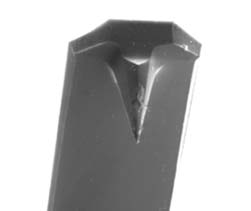How do we know if a molecule has a shape? Well, there are various ways, but the most direct is to use a very powerful microscope like the atomic force microscope. That is what Seth Darling used to “see” his surfaces and all those shapes that make it look like waves on the ocean.
The world’s most powerful micro- scopes don’t see things with light.
They see things by feeling with a very sharp tip on the end of something that looks like a needle. The tip is so sharp that it’s only a few atoms wide, so as it is moved across something tiny, like a single molecule, it can feel the shape.
These very powerful microscopes are called atomic force microscopes, because they can see things by feeling the forces between atoms. So with an atomic force microscope you can see things as small as a strand of DNA or even individual atoms.
These microscopes use computers to help convert the information from tapping on a surface to generate a three-dimensional view of an object. So with the world’s most powerful microscope, scientists have been able to ”see” DNA and report that it is a double helix just like Watson and Crick showed over 50 years ago! Or, more recently, Seth Darling was able to see his material.

